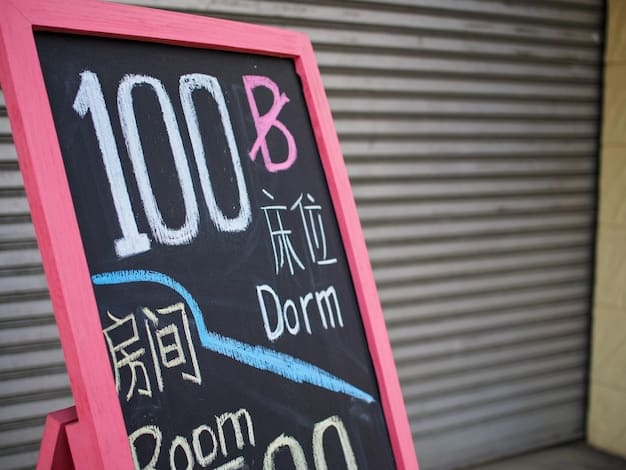Unlock Hidden Savings: Tax-Free Shopping Guide for US Residents in Japan 2025

Unlock Hidden Savings: The Ultimate Guide to Tax-Free Shopping for US Residents in Japan in 2025 provides a comprehensive overview of eligibility, procedures, and tips for American citizens shopping in Japan to maximize their tax-free benefits, ensuring a cost-effective and enjoyable shopping experience.
Planning a trip to Japan in 2025? Discover how to Unlock Hidden Savings: The Ultimate Guide to Tax-Free Shopping for US Residents in Japan in 2025, and make the most of your shopping sprees with this ultimate guide.
understanding Tax-Free Shopping in Japan for US Residents
Tax-free shopping in Japan presents a fantastic opportunity for US residents to save money on purchases. The system is designed to encourage tourism and boost the local economy. Let’s delve into the specifics of how this works and who is eligible.
To fully benefit from tax-free shopping, understanding the eligibility criteria and the process is vital. This knowledge enables US residents to shop smartly and enjoy significant savings.
Eligibility Criteria for US Residents
To qualify for tax-free shopping, US residents must meet specific conditions. Here are the key requirements:
- Non-Resident Status: You must be a non-resident of Japan. This typically means you’re visiting for a short period, usually less than six months.
- Passport Requirement: You need to present your passport to prove your non-resident status. Ensure your passport is valid and readily available when making purchases.
- Purchase Purpose: The goods purchased must be intended for personal use and taken out of Japan. Items bought for commercial purposes or resale are not eligible.
Meeting these criteria ensures you can take advantage of tax-free shopping during your visit, making your purchases more affordable.
Eligible Goods for Tax Exemption
Not all items qualify for tax exemption. Understanding which goods are eligible will help you plan your shopping:
- General Goods: These include clothing, accessories, electronics, and souvenirs. The minimum purchase amount is usually 5,000 yen per store per day.
- Consumables: This category includes food, beverages, cosmetics, and medicines. These items have stricter rules, such as being packaged in a specific manner and requiring the purchaser to leave Japan within 30 days of purchase.
- Combined Purchases: Some stores allow combining general goods and consumables to meet the minimum purchase requirement, but be mindful of the different regulations for each category.
Knowing the types of goods that qualify can help you maximize your tax-free benefits and avoid any complications at the point of purchase.
Understanding these basics is crucial for US residents looking to take advantage of tax-free shopping in Japan. Properly following the rules ensures a smooth and beneficial shopping journey.
step-by-step Guide to Tax-Free Shopping
Navigating the tax-free shopping process in Japan is straightforward, but it’s essential to know the steps involved. This guide breaks down the process to ensure a hassle-free experience.
From finding eligible stores to completing the necessary paperwork, following each step carefully ensures you receive your tax refund and comply with Japanese regulations.
Finding Tax-Free Stores
Identifying tax-free stores is the first step. Look for these indicators:
- Tax-Free Shopping Sign: Most tax-free stores display a prominent sign, often written in multiple languages, indicating their eligibility.
- Information Counters: Large department stores and shopping malls usually have information counters where you can inquire about tax-free shopping.
- Online Directories: Several websites and apps provide directories of tax-free stores in Japan. Utilize these resources to plan your shopping route.
By proactively locating these stores, you can ensure you’re shopping at locations that offer tax-free benefits.
The Purchase Process
Once you’re in a tax-free store, follow these steps when making a purchase:
- Meet the Minimum Purchase: Ensure your total purchase meets the minimum requirement, typically 5,000 yen per store per day.
- Present Your Passport: Show your passport at the cashier to prove your non-resident status. The staff will verify your eligibility.
- Complete the Documentation: Fill out the necessary forms provided by the store. This usually includes your name, passport number, and purchase details.
Following these steps at the point of purchase ensures a smooth and efficient tax-free transaction.
Receiving Your Tax Refund
There are two primary ways to receive your tax refund:
- Instant Refund: Many stores offer an instant refund at the point of purchase. The sales tax amount is deducted from your total bill immediately.
- Tax Refund Counter: In some cases, you may need to visit a tax refund counter within the store to process your refund after making the purchase.
Knowing how you’ll receive your refund helps you plan accordingly and ensures you don’t miss out on your savings.

By understanding and following these steps, US residents can confidently navigate the tax-free shopping process in Japan, making the most of their shopping experience.
tips and Tricks for Maximizing Savings
To truly maximize your savings with tax-free shopping in Japan, consider these additional tips and tricks. These strategies will help you optimize your shopping and ensure you get the most value for your money.
These tips range from strategic planning to practical in-store actions, all designed to enhance your tax-free shopping experience.
Plan Your Purchases
Strategic planning is key to maximizing your savings:
- Consolidate Purchases: Try to make larger purchases in a single store to meet the minimum spending requirement easily.
- Research Prices: Compare prices between different stores to ensure you’re getting the best deals before making a tax-free purchase.
- Seasonal Sales: Time your shopping during seasonal sales or special promotions to combine tax-free benefits with discounted prices.
Thoughtful planning can dramatically increase your savings and make your shopping more efficient.
Understand Store Policies
Familiarize yourself with the specific policies of each store:
- Minimum Spending: Be aware of the minimum purchase amount required for tax-free eligibility, which may vary slightly between stores.
- Eligible Items: Confirm which products qualify for tax exemption, especially if you’re buying a mix of general goods and consumables.
- Return Policies: Understand the store’s return policy for tax-free items, as there may be restrictions on returns or exchanges.
Knowing these details upfront helps avoid any misunderstandings or complications during your shopping.
Utilize Technology
Leverage technology to enhance your shopping experience:
- Shopping Apps: Use mobile apps that provide information on tax-free stores, product prices, and special deals.
- Translation Tools: Employ translation apps to understand product descriptions and store policies if you’re not fluent in Japanese.
- Currency Converters: Keep a currency converter handy to quickly calculate prices in USD and ensure you’re staying within your budget.
Smart use of technology can make your shopping more efficient and enjoyable.
By incorporating these tips and tricks into your shopping strategy, US residents can significantly increase their savings and enjoy a more rewarding tax-free shopping experience in Japan.
navigating Common Pitfalls
Even with careful planning, certain pitfalls can arise during tax-free shopping in Japan. Being aware of these common issues and how to avoid them can save you time and frustration.
This section highlights frequently encountered problems and provides practical solutions to ensure a smooth and successful shopping experience.
Incorrect Documentation
Inaccurate or incomplete paperwork can cause issues. Here’s how to prevent them:
- Double-Check Forms: Always review the tax-free forms to ensure all information is accurate, especially your passport number and purchase details.
- Keep Receipts: Retain all receipts associated with your tax-free purchases. These may be required for verification purposes.
- Seek Assistance: If you’re unsure about any part of the form, don’t hesitate to ask store staff for assistance.
Attention to detail in documentation can prevent delays and ensure your tax refund is processed correctly.
Misunderstanding Eligibility
Failing to meet eligibility requirements can lead to denial of tax benefits. Be mindful of these points:
- Residency Status: Ensure you genuinely meet the non-resident status requirement. Overstaying your visa or having a long-term resident permit disqualifies you.
- Purchase Intention: Only buy items intended for personal use and export. Goods for resale or commercial purposes are not eligible.
- Minimum Spending: Verify that your purchase meets the minimum spending threshold per store per day.
Clarifying your eligibility beforehand can avoid disappointment and ensure you qualify for tax-free shopping.
Customs Issues
Problems can arise when leaving Japan if you don’t follow customs regulations:
- Keep Items Sealed: Consumables purchased tax-free must remain sealed and unopened until you leave Japan.
- Carry Items with You: Keep your tax-free purchased items with you in your carry-on luggage. Do not pack them in your checked baggage.
- Be Prepared for Inspection: Be ready to present your passport, receipts, and purchased items to customs officials if requested.

Adhering to customs regulations is crucial for a smooth departure and to avoid potential penalties.
By being aware of these common pitfalls and taking proactive steps to avoid them, US residents can navigate tax-free shopping in Japan with confidence and ease.
changes to expect in 2025
As with any system, the rules and regulations for tax-free shopping in Japan may evolve. Staying informed about potential changes expected in 2025 is essential for US residents planning to shop.
This section provides insights into possible updates and adjustments to the tax-free system, helping you prepare for your shopping trip.
Potential Policy Updates
Keep an eye out for these potential policy updates:
While specific details are still uncertain, these broader trends suggest a move towards greater efficiency and accessibility in the tax-free shopping system.
Technological Advancements
Technology may play an increasing role in tax-free shopping:
- Digital Tax-Free Forms: The introduction of digital tax-free forms could streamline the paperwork process, reducing errors and saving time.
- Mobile Payment Integration: Integrating tax-free refunds with mobile payment systems like Apple Pay or Google Pay could offer a more convenient refund method.
- AI-Powered Assistance: AI-powered shopping assistants could provide real-time information on tax-free eligibility, store locations, and product prices.
These advancements aim to make the shopping experience more seamless and user-friendly for tourists.
Impact on US Residents
These changes could have several implications for US residents:
By staying informed about these potential changes, US residents can better prepare for their tax-free shopping experience in Japan in 2025.
| Key Point | Brief Description |
|---|---|
| ✅ Eligibility | Non-resident status with a valid passport required. |
| 💰 Minimum Purchase | 5,000 yen at one store per day needed for tax exemption. |
| 🛍️ Eligible Goods | General goods and consumables (food, cosmetics) qualify. |
| 🛂 Customs Rules | Keep consumables sealed and carry all items in carry-on bags. |
FAQ: Tax-Free Shopping in Japan
▼
The current consumption tax rate in Japan is 10%. Shopping tax-free allows eligible tourists to avoid paying this tax on their purchases, resulting in significant savings.
▼
No, you cannot combine receipts from different stores. The minimum purchase requirement must be met at a single store on the same day for tax-free eligibility.
▼
If you open sealed consumables before leaving Japan, you are technically supposed to pay the consumption tax. However, this is rarely enforced if the items are for personal consumption.
▼
Yes, not all stores participate in the tax-free shopping program. Look for the “Tax-Free Shopping” sign or inquire at the store to confirm their participation before making a purchase.
▼
You may be asked to show your tax-free purchases and passport at customs. Keeping your receipts and items readily accessible can streamline this process.
conclusion
By understanding the ins and outs of tax-free shopping in Japan, US residents can unlock significant savings and enhance their travel experience. From meeting eligibility requirements to navigating store policies and staying informed about potential changes, this guide equips you with the knowledge to shop smartly and make the most of your visit in 2025.





